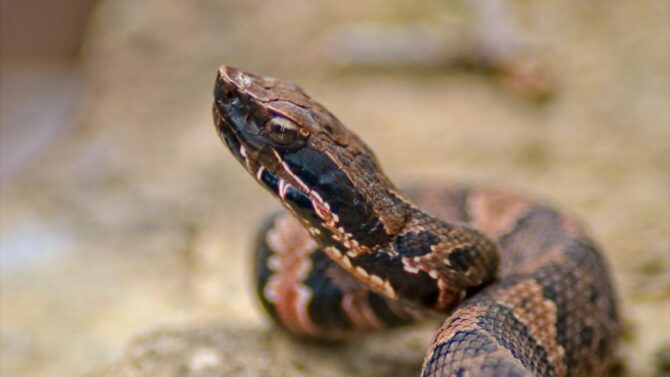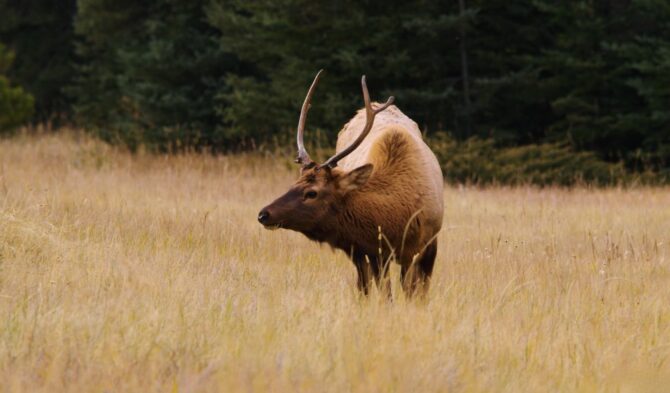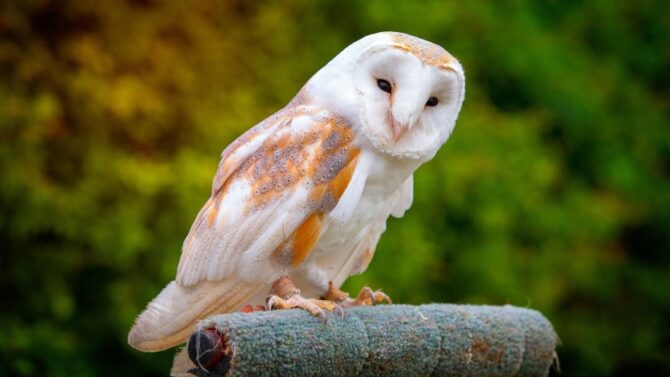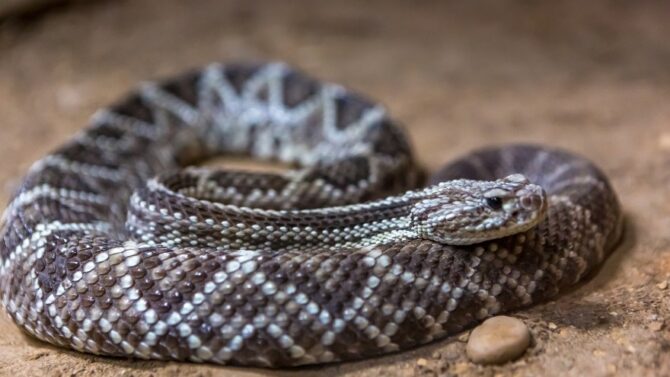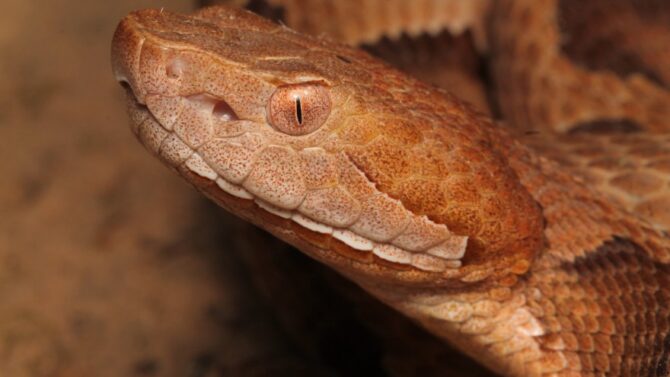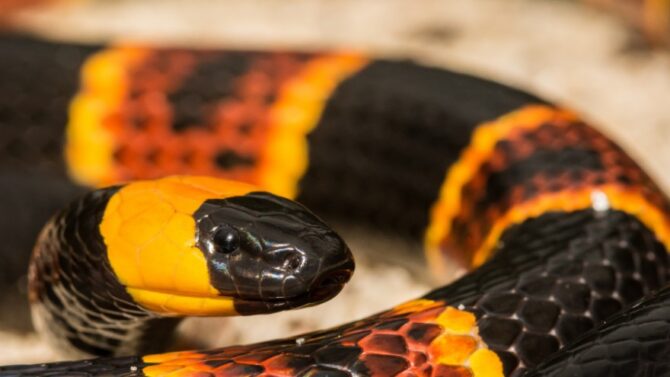Tennessee is a landlocked state in the Southeastern region of the United States.
It is a beautiful state and home to the Great Smoky Mountains and abundant wildlife, including many species of snakes.
According to the Tennessee Wildlife Resources Agency, there are 32 different species of snakes in Tennessee.1
However, only four of them are venomous.
The four venomous snakes in Tennessee are the copperhead, the timber rattlesnake, the western cottonmouth, and the western pygmy rattlesnake.
Hikers and mountain climbers exploring the wild of Tennessee should always be careful to avoid getting bitten by any of these snakes, as their bites can be fatal.
Now, let’s delve into each of these venomous snakes and learn more about their characteristics and habitats.
4 Venomous Snakes in Tennessee
1. Copperhead
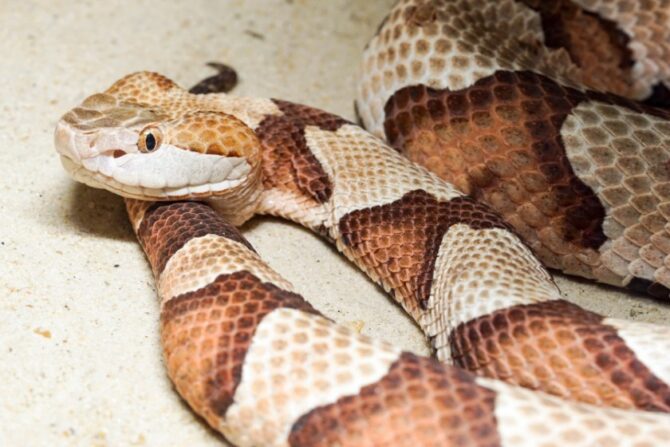
- Scientific Name: Agkistrodon contortrix
- Size: 24 to 36 inches
- Habitat: Forest and water areas
- Identifying Features: Triangular heads, pits on both sides of their snots, coppery eyes with vertical pupils, and hourglass-shaped bands across its body
- Behavior: Secretive or shy, loud hissing, nocturnal, vibrating tail.
- Threats to Humans: Excruciating pain, a tingling sensation, throbbing, swelling, nausea, vomiting, and death
The copperhead is found mostly in the eastern part of Tennessee.
This venomous snake resides in the forest and water areas, although it’s often hard to spot, as it camouflages well with its surroundings.
While copperheads generally aren’t aggressive, and their bites are rarely fatal, they should still be avoided at all costs.
Copperheads tend to avoid humans, but if disturbed or accidentally stepped on, they usually bite in self-defense.
If a person gets bitten by a copperhead, they may experience several symptoms, including severe pain, a tingling sensation, throbbing, swelling, nausea, vomiting, dizziness, paralysis, and, in extreme cases, cardiac arrest.
2. Cottonmouth
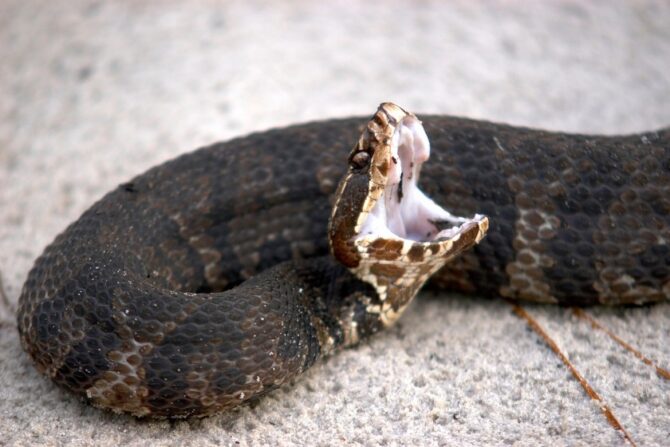
- Scientific Name: Agkistrodon piscivorus
- Size: 30 to 42 inches
- Habitat: Swamps, sloughs, wetlands, and the drainage ditches of the western coastal plain; occasionally found around rivers and lakes
- Identifying Features: Dark olive-brown color, plain or patterned body with dark blotches, thick body, and a mouth as white as cotton (which is where it derives its name)
- Behavior: Violent flight, rapid crawling, and flickering of tongue
- Threats to Humans: Dangerous bite, extreme pain, swelling, tissue damage, excessive bleeding, the inability of blood to clot, and, occasionally, amputation
The cottonmouth, also known as the water moccasin, is a venomous snake that belongs to the pit viper subfamily.
As a semi-aquatic reptile, this snake is mostly found near slow-moving water bodies and shallow lakes.
When threatened, cottonmouths usually display aggressive behaviors, like vibrating their tails and exposing the white interior of their mouth.
It’s very important to avoid cottonmouths, as their bites can be deadly.
Their venom contains toxic enzymes that can cause tissue damage in their victims.
Besides destroying tissues, their bites can also cause severe pain and swelling, bruises, loss of arms and legs, and even death.
3. Timber Rattlesnake
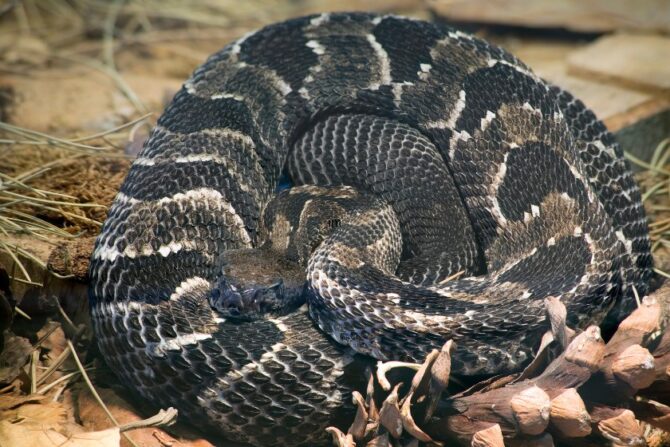
- Scientific Name: Crotalus horridus
- Size: 36 to 60 inches
- Habitat: Deciduous forests with rocky hillsides, mountains, swamps, wooded stream corridors, and rural habitats
- Identifying Features: Gray body, black tail, rattle, thick body, black chevron-shaped crossbands down the body, reddish-brown stripe down the center of the back, and brown specks sprinkled across its tan or light gray belly
- Behavior: Nocturnal in summer and loves to camouflage.
- Threats to Humans: Dangerous bite, bleeding, cell death, skin discoloration, paralysis, cardiac arrest, numbness, and death
The timber rattlesnake, also called the canebrake, is a rattlesnake species in Tennessee.
It’s the second-largest venomous snake in the United States.2
One distinguishing feature of timber rattlesnakes is the prominent rattle at the end of their tails.
They also have a large and thick body with angular heads.
The venom of timber rattlesnakes is a deadly mix of neurotoxins and hemotoxins.
When bitten by these snakes, victims usually experience severe pain, swelling, consistent bleeding, cell death, and other symptoms.
Therefore, hikers should watch out for these dangerous reptiles when exploring areas in Tennessee known to be their habitats.
4. Western Pygmy Rattlesnake
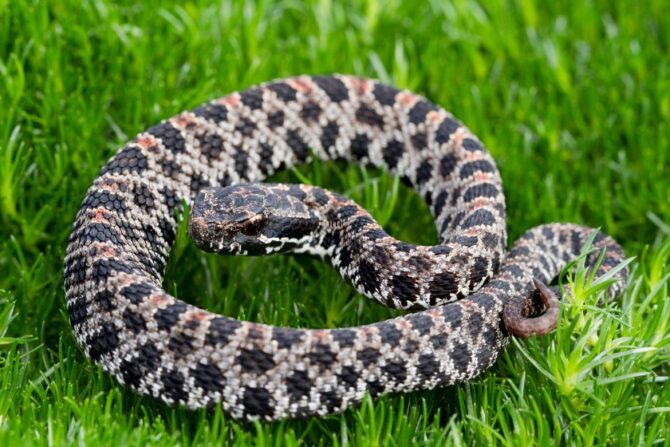
- Scientific Name: Sistrurus miliarius streckeri
- Size: 15 to 20 inches
- Habitat: Moist fields, flood plains, wetlands, rocky uplands, pine woods, and glades
- Identifying Features: Small, colorful, slender tail with a tiny rattle that makes faint noise, gray or tan with an orangish-brown mid-dorsal stripe, and dark blotches on its head and along its back; young pygmy rattlesnakes have yellow-tipped tails
- Behavior: Basks in the sun itself during summer
- Threats to Humans: Painful bite, bleeding, redness, skin discoloration, paralysis, and respiratory disorder
The western pygmy rattlesnake is a small venomous snake.
These snakes usually have a bright or dark color and a small rattle, which, when vibrated, sounds more like a buzzing insect than a rattlesnake.
They are usually found in moist fields, flood plains, and wetlands, though sometimes, they can also be found in rocky uplands, pine woods, and glades.3
When threatened, western pygmy rattlesnakes defend themselves in various ways.
Some coil up, vibrate their rattles, jerk their heads, and strike the threat.
Others will just slither away to avoid confrontation.
Western pygmies are so secretive that only a few people encounter them.
The western pygmy rattlesnake’s venom is fatal, which is why it must be avoided at all costs.
When bitten by this snake, victims may experience severe pain, bleeding, redness, skin darkening, paralysis, and cardiac arrest.
In extreme cases, the victims may die.
Conclusion
To avoid getting bitten by any of the venomous snakes in Tennessee, it’s crucial to be cautious, especially when exploring the great outdoors and mountainsides.
Most of these venomous snakes generally avoid humans and strike only when they feel threatened or are mistakenly stepped on or cornered.
However, if you get bitten by any of these venomous snakes, make sure you treat it as an emergency.
When it comes to venomous snakebites, urgent treatment can be the difference between life and death.
References & Notes
Facts Sources:
- Snakes. State of Tennessee Wildlife Resources Agency
- Timber Rattlesnake (Crotalus horridus). Texas Parks & Wildlife Department
- Pygmy Rattlesnake. State of Tennessee, Wildlife Resources Agency
